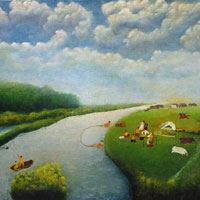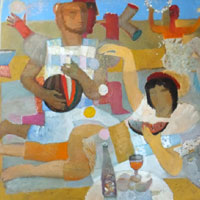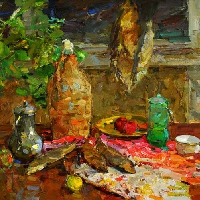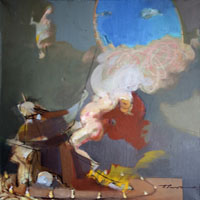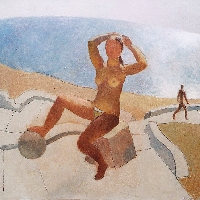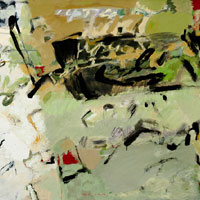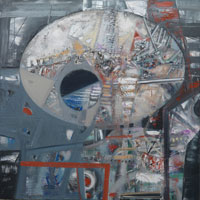
A counter current of interest was from Western art historians, specializing in Russian art, who told each other "Go to Kyiv, there is Bohomazov." As it turned out, the roots of Russian Avant-garde could be found in Ukraine. For example, what was Goncharova's paintings inspired with? the Polovtsian stone images on the steppes of Ukraine. Which cities were associated with the life and work of the Futurist and trans-rationalist Terentyev? Kherson, Kharkiv, Odessa and Dnipropetrovsk. Why did Malevych make such frequent mentions of Pymonenko and "the famous master from Chernihiv, Murashko" in the last years of his life? What does the title of Exter's painting, Fundukleyivska at Night, mean? How can you explain why Davyd Burlyuk called himself a 'Tartar-Za-porozhian Futurist'? How did it happen that Matyushin, prohibited in Leningrad, was readily published in Kharkiv?
Deciding these questions, some Western historians of Russian art became historians of Ukrainian Avant-garde as well (the Marcades France, Boiko Poland, Bowlt the USA, Nakov France, Mudrak the USA).
Furthermore, well-known London art collector, Mr. Lobanov-Rostovsky, collects sketches by stage designers of the Kyiv school, Exter, Meller, Petrytsky, Khvostov, Rabynovych, Tyshler and Chelishchev. At the 1988 exhibition of his collection of paintings in Moscow, he told me with conviction: 'You must write a book on five uniquely gifted Ukrainian artists: Arkhypenko, Bohomazov, Exter, Yermylov and Petrytsky." I gladly consented to this proposition adding to the list some more names Malevych, Palmov, Tatlin, Burlyuk and Boichuk. These are the great names around which dozens of students and adherents grouped establishing various art trends, schools and currents. Through them, Ukrainian culture was rapidly Europeanized, while in Europe and America it began to breathe with Rus-Ukraine. Unfortunately, Stalin's terror cut off informatbn of Ukrainian art to the world.
...The notion 'Ukrainian Avant-garde' was introduced by Paris art critic, Nakov, in reference to the exhibition, Tatlin's Dream, held in London in 1973. For the first time ever, the West saw world-class works by Yermylov and Bohomazov, two obscure Avant-gardists from Ukraine. Their works brought to mind the names of world-famous masters whose origin, education, self-perception and national traditions were linked with Kyiv, Kharkiv, Lviv, Odessa and with the Ukrainian cultural tradition in general. Among them were Burlyuk, "the most faithful son of Ukraine," the Pole, Malevych, who considered himself to be a Ukrainian; Tatlin, professor of the Kyiv Art Institute and bandura-player; Exter, the founder of the Ukrainian school of constructivist stage design. And lastly, Arkhypenko, who was inspired by his indelible impressions of his homeland, the magic of the Tripillya civilizatbn. the archaic Polovtsian stone images, the resonant contours of mosaics in the St. Sophia of Kyiv and reliefs of St. Michael's Cathedral of the Golden Domes, and the colours of folk ceramics.
Dmytro Gorbachev,
"Ukrainian Avant-Garde Art 1910s-1930s",
"ART" Publisher, 1996, Kyiv

